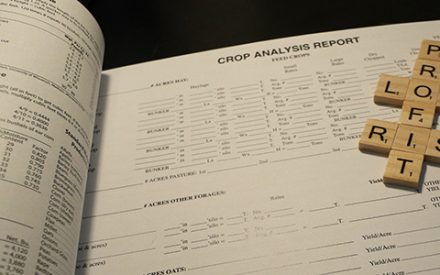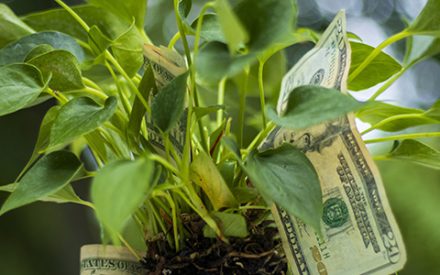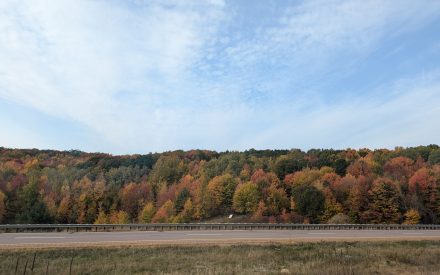Video Summary
In this video, Dr. Damon Smith, UW–Madison Field Crop Pathologist, provides an early season update on crop disease risks and management strategies for Wisconsin. He covers current conditions for stripe rust and Fusarium head blight in winter wheat, emphasizing the importance of timely fungicide applications during anthesis.
Dr. Smith also discusses soybean seedling health, including ILeVO halo symptoms and white mold risk, and addresses early corn disease concerns like anthracnose leaf blight and tar spot. He introduces updated digital tools for disease forecasting, replacing former mobile apps, and offers guidance on using these platforms for informed, cost-effective disease management decisions.
Resources
- Written version of this talk – Badger Crop Network
Transcript
0:08
As Landon pointed out, yes, if you do not want to listen to me and you don’t want to hear me say the word kurtosis like Doctor Conley just did, you can zone out and actually check out this entire presentation and and written form at this QR code.
0:24
And it is the latest article on the Badger Crop Network website.
0:29
So if you forget something, feel free to go back and look at the look at the web page.
0:35
I do want to start out with some winter wheat and talk about stripe rust and the stripe rust situation.
0:42
There was quite a bit of stripe rust reported earlier this season in Oklahoma and Kansas.
0:46
As you can see by the latest map here, we did find stripe rust, probably not too surprisingly, given the pressure to our southwest in in the Arlington area last week.
1:00
We are watching that situation and it is continuing to move up the plant and, and, and across the the field.
1:07
Admittedly, that is a susceptible variety out there.
1:11
We are watching some of the resistant varieties as well to try to understand what’s going on there and we’ll be getting a look at the variety trials coming along.
1:20
But the pressure is here.
1:21
The inoculum apparently has arrived.
1:24
The weather conditions are very conducive for stripe rust.
1:27
It loves it these cooler temps and when we have periodic rains and elevated humidity.
1:32
So we’re right in the sweet spot really for for stripe rust development.
1:37
The other disease of course we’re interested in right now is Fusarium head blight or scab.
1:43
Currently the risk for scab this was yesterday’s map.
1:49
It’s currently low across most of the state with some medium and high and in a couple of spots there, you know, close to Kewaunee County and then kind of in the center of the state, North Central part of the state.
2:04
I don’t know how I feel about this map.
2:06
We’ve we’ve struggled in the past with the headlight models here in the state.
2:12
Temperature seems to be the major driver here and that’s one of the reasons why it is fairly low in terms of risk at the moment.
2:19
It’s because of the cooler temperature conditions.
2:21
We’ve certainly had the moisture and relative humidity across the state, but the models are telling us that the temperatures haven’t quite been there.
2:28
I’m going to watch the situation.
2:30
I would say it’d be cautious there.
2:31
We do know of certain islets that can infect at some of these lower temperature levels.
2:39
So it is something that I want folks to be aware of maybe think about that fungicide application.
2:47
Really taking that together, it’s, it’s hard not to recommend a fungicide application at that anthesis point.
2:54
And we do have some efficacy tables available with ratings.
2:58
So the QR code there will take you there.
3:02
We’re right in that sweet spot right now.
3:05
And one reason why I think of this particular application this year is going to be really important is not only from the head scab standpoint, but all the fungicides that are rated good for head scab are also rated excellent or very good for stripe rusts.
3:22
So again, you know we’ve got a couple of diseases here.
3:24
Both can take substantial yield from us. A single fungicide application.
3:29
There’s a high probability of actually recovering a return on investment on that single fungicide application at the anthesis stage.
3:37
So I think if the price is right locally and it’s just not exorbitantly high, I would be thinking about that application.
3:46
We also, in addition to the efficacy tool or efficacy guides, we also have this interactive efficacy tool.
3:53
So if you don’t want to have to go in and kind of study everything on that chart, you can go to this tool through the Crop Protection Network.
4:01
All of our ratings from Wisconsin and other states go into this tool and you can actually sort that tool based on the crop and disease and and general ratings.
4:10
And so what I like to do is go in, find the good head scab products and then just double check those stripe rust ratings on those particular products.
4:18
But you do have some good options there and things that will get both diseases in, in terms of that optimal timing, Sean talked about, you know, we’re right at that anthesis timing or or maybe even past.
4:32
And we’ve done quite a bit of work looking at really what, what does that window look like.
4:37
We know very much, you know, lots of data points suggesting that that 10.5.1 is probably the best place to to really start looking at this.
4:47
How late can you go?
4:48
You can actually go five to seven days after the start of anthesis.
4:52
And so anthesis, you can see 10.5.1 right here where we have several anthers out kind of that upper third of the of the head.
5:01
If you have 50% of the heads in a field showing this grow stage, you mark that as, as you know the anthesis start, then you have five to seven days after that to actually get your fungicide application on.
5:16
And interestingly enough, we’ve, we’ve done some work to show that actually the five day delayed applications really do a nice job of actually reducing the mycotoxin levels.
5:28
So the damage the disease causes is comparable to the to the anthesis timing applications, but we do a better job of actually reducing the mycotoxin levels in the finished grain if we delay that application by about 5 days or so.
5:43
And part of that is we think that it’s about secondary tillers catching up and unevenness in the field.
5:49
And we do just a better job of controlling those later infections with those applications that are delayed.
5:55
You do need to be a little bit careful because once you get outside that 7 to 10 day window, it’s almost like you didn’t do anything at all.
6:01
So if you can’t just get on it, you don’t want to have access to the sprayer.
6:05
You’re kind of dependent on somebody else and those sorts of things go at anthesis.
6:10
But if you can control things, delaying 5 days is, is really the sweet spot.
6:16
Other diseases in winter wheat.
6:18
We’ve been getting a lot of questions on cephalosporium stripe.
6:22
You’ll remember maybe from the 2019 growing season, we had quite a bit of cephalosporium stripe around that year.
6:28
We actually got some ratings in Sean’s variety trials and those ratings are published.
6:32
You can go check those out on the 2019 VT trials.
6:37
Anecdotally this disease can be pretty significant if it’s across the wide swath of the field.
6:44
Anecdotally you know yields of 20 bushels per acre and more reductions for this disease.
6:50
So it is significant.
6:52
It does seem to be varietal dependent and and also stress dependent to a certain extent.
6:58
There unfortunately is no in season management.
7:00
So our foliar fungicide applications aren’t going to do anything here.
7:03
This is kind of a resistance issue that we’re seeing in our tight rotation.
7:08
So I think you know where we’re seeing it pop up is in fields where the rotation between wheat crops is a little closer.
7:17
The winter stress likely contributing to that, you know, lack of snow cover with the cold conditions that we had out there and then some susceptible varieties out there as well.
7:29
Right now, I think the thing to do is to mark those fields, know where ceph stripe is, and then make some decisions for that next crop and and especially study the variety of trials.
7:40
We’re going to try to get some ratings out of out of the variety trials this year.
7:44
I think one of Sean’s locations is showing some.
7:47
So hopefully we can get some reports and and folks can actually look at some of those, some of those resistant varieties out there. Transitioning over into soybeans.
7:58
Sean talked a lot about kind of just where we’re at, you know from a growth stage standpoint, things from a disease standpoint actually look pretty good.
8:06
We were a little concerned about Pythium and Phytophthora earlier in the season, kind of we had some moisture there, but it turns out that hasn’t been really a significant issue for us.
8:16
What we have seen a lot of is a ILEVO Halo out there.
8:20
So those of you who have dealt with the ILEVO seed treatment probably run into this before where the cotyledens can can take on this haloed necrotic look to them.
8:31
And then the the plant, the the kind of the newer growth will actually have some stippling.
8:36
And a lot of this is it’s an interaction to cooler temperatures and then pre emergence herbicides.
8:41
And there’s been quite a bit of work to look at this.
8:44
The beans do look not so great when you’re looking at them, but they, they always grow out of it.
8:50
So my, my message here is yes, it’s out there.
8:55
You’ll see it this year.
8:56
It’s probably especially apparent this year because of the cool conditions.
9:00
But it be patient.
9:02
The, the crop will grow a lot of it and there is no yield drag associated with that, that Halo effect.
9:08
What I am wanting folks to pay attention to is if we continue in this cool pattern with these intermittent rains and this higher humidity that we’re seeing.
9:17
I am, you know, getting increasingly concerned about white mold risk out there as we approach them in the middle part of the season.
9:23
So folks should be watching this making sure that they know which fields have a history, those higher seeding rate fields.
9:31
So Sean talked a lot about higher seeding rates.
9:33
We also know from some of that work that once those populations are down in the 90 to 100,000 range, white mold risk goes down quite a bit.
9:41
So if you if you know a field has a higher population, those fields would be a higher risk and maybe benefit from fungicide applications if we stay in this kind of cool wet period in terms of the corn diseases out there.
9:55
Beginning a little bit of questions like I do every year about anthracnose leaf blight.
10:02
Do not spray a fungicide for anthracnose leaf blight that shows up almost every year, especially on corn on corn acres and no till corn on corn acres.
10:12
It’s a it’s an artifact of juvenile leaves.
10:15
So plants that are younger than that V6 grow stage, those leaves are considered juvenile leaves.
10:20
They are abnormally susceptible to leaf blight.
10:24
There was some work done here at Wisconsin by my predecessor that showed that the leaf blight phase is not linked to the stalk rot phase.
10:33
So you do not need to worry about stalk rot if you are seeing leaf blight and do not waste your your pennies on fungicide applications, especially in this tight economy.
10:42
It’s going to be really hard to recover that money with these early applications.
10:47
We just don’t see the yield benefits there.
10:49
So just be patient.
10:50
These corn plants, once they get to the V6V7 grow stages, they’ll become more resistant.
10:56
You’ll you won’t see any more leaf blight.
10:58
So this is sort of a perennial problem.
11:01
One thing we are paying attention to and I I’ve already done a couple of news interviews this morning already, my colleagues in Kansas and then Indiana this morning posted their first finds of Tarspot in those states.
11:17
So you can see the map there.
11:19
This is extremely early, although the weather has been just about prime for across the Midwest and I would say prime in Wisconsin.
11:27
But generally speaking, our plants are at a really short at a growth stage that’s nowhere near where we need to be thinking about a fungicide application.
11:37
I think what we need to be doing is just paying attention to fields that had high tar spot last year.
11:43
We should be in those fields.
11:45
If we have corn in those fields again this year, we should be scouting and keeping track of the situation.
11:50
Again, an early fungicide application is not warranted right now.
11:53
You’re not going to see the returns there.
11:55
The leaves that are infected now are not going to be there by the time we get the harvest.
11:59
We need to have those fungicides on the leaves that are are going to be making grain for us.
12:04
That’s where the best protection is.
12:07
Also remember that fungicides don’t last very long.
12:09
They’re only going to be in the plants about 30 days.
12:12
So if you make an application now, you’re going to be, you know, needing probably to make an application at that Vt to kind of R3 grow stage window.
12:20
So I would rather folks keep that fungicide application in their toolbox, hold that money and then make that investment in a well timed application later in the season.
12:32
Base it on what’s going on with our prediction models and then also combine that with your scouting.
12:37
But do get out there, do scout, pay attention to what’s going on?
12:42
Those of you in the central part of the state, We had a, we had a pretty good band of, of tar spot last year kind of across that central sands area.
12:50
Those would be areas where we’d want to be out there just scouting and keeping track of what’s going on with that particular disease situation.
12:58
Just to finish up here in the last few minutes, I do want to just show you some other resources.
13:02
The fungicide, the Badger Crop Doc fungicide test summary is out there.
13:07
You can check those test summaries out at badgercropnetwork.com.
13:13
Do make sure you’re going back and looking at the past years and look at things that are consistent over time.
13:20
In a year like this where margins are really tight, I’d urge you to check out the corn fungicide ROI calculator that’s on on the Crop Protection Network.
13:30
This particular tool was developed here at the University of Wisconsin based on data across the whole US.
13:36
And it uses real world data and some simulations to give us expected net benefits and break even probabilities.
13:45
And you can enter some things like your expected yield, the commodity prices, you can even change the pricing.
13:50
We have some default pricing for some of the products in there, but you can get your local pricing and enter those into those boxes.
13:56
And then the simulation will rerun itself and then give you the expected net benefits and break even probabilities for those various scenarios.
14:04
So run those scenarios.
14:06
Do make sure that you’re looking at both of these columns together.
14:10
OK?
14:11
So what you might want to be inclined to do is look at the expected net benefit per acre, which in some cases it can be very high, but the break even probability in those cases might be very low.
14:21
Those things are two different things and they but they do need to be considered together, you know, and the best way to talk about this is sort of high risk, high reward, right?
14:30
So if you, you can have a high expected net benefit, but a low break even, right?
14:35
And what that means is that when it does break even, it it does really well, but the probability of it actually breaking even is actually actually rather low, right?
14:45
So pay attention to that.
14:47
Look at what’s going on, take all the data together and be honest with yourself, with those, with those various scenarios.
14:55
I also want to bring your attention to the fact that Sporecaster, Tarspotter, Sporebuster, Field Profit, they’re all dead.
15:03
All the apps are actually dead.
15:05
They’ll be wiped out of the various stores come July.
15:10
We’ve transitioned over into a new online dynamic apps where we’re actually combining all the tools together into one place.
15:17
And so for for us here in Wisconsin, we actually have the agricultural forecasting advisory system which has been developed, which houses all the tools that were previously housed in those stand alone apps.
15:28
The nice thing about this particular tool is it does use the Wisco Net weather station network and so any of the stations nearby you, you can actually get the actual measured weather that comes in and and is used to calculate the risk indices for the various diseases.
15:44
So it is a nice way to sort of get the real world information.
15:48
You can also click on this toggle here and this will toggle over to the gridded weather data sets which we’ve used for years.
15:54
And you can actually drop a pin just like you could in the apps and actually get some more of a site specific tailored disease prediction there.
16:03
We also have another tool which it runs nationally.
16:06
This is found at the the crop on the Crop Protection Network site.
16:11
This one you prepopulate your pins, it’ll actually save those in your browser using a cookie.
16:19
So you do need to come back to the same computer to have those locations saved, but once you’ve uploaded those or dropped your pin there they are saved.
16:29
The nice thing about this tool is that actually includes more crops.
16:32
So in addition to corn and soybeans, we have potato, carrot, beet and onion models pulled in there.
16:37
We are going to be loading more models on this site.
16:40
So this is a nice place where you can sort of get a one stop shop and I’m actually running for last season here.
16:46
You can actually see the Arlington location for corn and you’re looking at Tarspot and also Gray Leaf Spot
16:51
risk for the entire season of 2024, so you can actually go back in time kind of look what’s going on.
16:58
We also offer a 7 day forecast in this tool so you can actually look ahead 7 days and kind of see what those risks are.
17:06
This does use the gridded IBM weather data set, so the same stuff that the weather network is using and all that kind of stuff.
17:14
It is on a 2 1/2 kilometer grid and that and it’s pretty accurate.
17:18
We’ve run quite a few accuracy tests against, you know, measured weather data out of our own loggers and in particular field situations.
17:26
We’ve run it against WISCO NET stations.
17:28
It does quite well.
17:29
And in fact the WISCO net feeds into these larger databases which all these other tools like the IBM tools are actually modeled on.
17:37
So a lot of that weather would be expected to be very similar and highly accurate.
17:42
So a couple of places where you can go to actually get those disease risks.
17:47
And again, the standalone apps are no longer going to be available.
17:52
So with that, I did want to make sure that we had plenty of time for questions for for the three of us that that talked today.
17:58
So I’ll just leave you here with my contact information.
18:02
As always, I’m on X or Twitter at Badger Crop doc.
18:06
My e-mail is probably the best way to get a hold of me damon.smith@wisc.edu.
18:10
And then of course the badgercropnetwork.com website where you can find all of the resources I talked about today, including both of the disease forecast tools.
18:22
So with that, I will stop share now and we can open things up to some questions.
Badger Crop Connect
Timely Crop Updates for Wisconsin
Second and fourth Thursdays 12:30 – 1:30 p.m.
Live via Zoom

 ▶ Fall 2025 Financial Assistance for Producers
▶ Fall 2025 Financial Assistance for Producers ▶ Fall 2025 Ag Policy Update
▶ Fall 2025 Ag Policy Update ▶ Fall 2025 Corn and Soybean Market Outlook
▶ Fall 2025 Corn and Soybean Market Outlook ▶ November 6 Ag Weather Outlook for Wisconsin
▶ November 6 Ag Weather Outlook for Wisconsin


